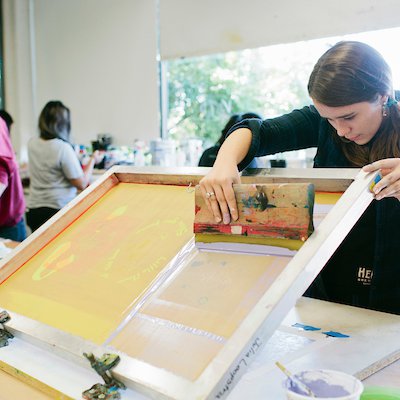The Crucial Guide to Understanding Screen Printing and Its Versatile Makes use of
Screen printing has an abundant background that goes back to ancient times, evolving right into a sophisticated method used throughout various sectors today. This guide discovers the complexities of the screen printing procedure, outlining its applications in advertising, fashion, and home décor - 10:9 Design LLC Company. Understanding these basics can open up innovative potential for both artistic and industrial projects. The complying with areas will expose crucial tips and methods to boost one's screen printing endeavors
The History of Screen Printing
Although screen printing has origins that map back centuries, its evolution shows the artistic and technological improvements of numerous societies. Stemming in old China, the strategy was originally made use of for decorating fabrics and later infect Japan, where it came to be integral to Ukiyo-e woodblock printing. The method shifted to Europe in the 18th century, where it gained popularity amongst craftsmens and business printers. The invention of photo solution in the 20th century revolutionized screen printing, allowing for even more detailed layouts and better performance. Musicians like Andy Warhol better moved its popularity, utilizing the tool to produce famous works that blended commercialism and art. By the late 20th century, screen printing had actually developed itself as a versatile technique, employed in fashion, marketing, and great art. Today, it remains to develop, integrating electronic modern technology and increasing its applications throughout different markets.
The Screen Printing Process Explained
Screen printing changes imaginative visions into substantial styles with a collection of exact steps. Initially, a photo is produced and afterwards transferred onto a screen, typically constructed from great mesh fabric extended over a framework. A light-sensitive solution is applied to the screen, which is exposed to light, setting in areas not covered by the photo. After washing out the unhardened solution, a pattern is created.
Next off, the screen is placed over the substratum, whether it be fabric, paper, or an additional material. Ink is after that pushed with the open areas of the pattern using a squeegee, transferring the design onto the substratum below. This procedure can be repeated for numerous colors, needing different screens for each color. The printed product is cured utilizing warmth to guarantee the ink adheres effectively, resulting in a durable, lively design prepared for usage.
Sorts Of Screen Printing Techniques

Additionally, specialized techniques, such as discharge screen printing, get rid of dye from the fabric to develop softer prints, while foil screen printing uses metallic aluminum foil to achieve a glossy finish (10:9 Design Embroidery). Each method offers unique attributes, satisfying numerous creative demands and production ranges, ultimately broadening the opportunities within the screen printing domain
Applications of Screen Printing in Different Industries

Additionally, the signs and advertising markets make use of screen printing for creating appealing screens and banners. This technique permits for vibrant shades click to find out more and elaborate styles that record focus. In electronic devices, screen printing is employed for applying conductive inks to circuit card, essential for component connections. The home style industry embraces screen printing to create distinctive designs on textiles and wall art. Generally, screen printing acts as a critical tool throughout varied areas, enhancing products with customized and visually enticing graphics.
Tips for Effective Screen Printing Projects
While carrying out a screen printing job, cautious interest to detail can significantly improve the last end result. Choosing top notch products is necessary; this consists of the screen, inks, and substrates. Using suitable mesh counts can influence ink deposition and detail resolution. Preparation is equally important; comprehensive cleaning of displays and correct exposure times guarantee crisp prints.
Next off, precise registration is vital for multi-color prints. Using alignment devices can aid accomplish exact layering. In addition, screening prints on scrap materials before manufacturing assists identify possible problems without wasting sources.

Often Asked Concerns
What Materials Are Best for Screen Printing on Fabric?
Cotton and polyester blends are optimal for screen printing on material as a result of their durability and ink absorption. Additionally, specialized textiles like silk or canvas can generate one-of-a-kind appearances and surfaces, improving the overall design top quality.
Just how Do I Tidy and Maintain Screen Printing Devices?
To clean up and maintain screen printing devices, one must consistently clean displays with suitable solvents, inspect mops for wear, oil relocating components, and shop all products in a dry, dust-free environment to lengthen their life expectancy.
What Are the Environmental Influences of Screen Printing?
Screen printing can have substantial environmental effects, including chemical waste from solvents and inks, water use during cleansing processes, and energy intake. Sustainable practices and eco-friendly products are vital for reducing these adverse effects.
Can Screen Printing Be Done at Home Successfully?
Screen printing can be efficiently done at home with the right materials and strategies. Hobbyists can develop high quality prints, though success relies on their ability level, devices, basics and understanding of the process straight from the source entailed.
What Are the Costs Related To Starting a Screen Printing Organization?

Starting a screen printing organization involves prices for devices, products, and workspace. Preliminary costs typically range from a few hundred to a number of thousand dollars, relying on the range, quality of machinery, and preferred manufacturing ability.
Screen printing has an abundant background that dates back to old times, advancing right into an advanced strategy used across various industries today. One more method, rotating screen printing, uses round screens, helping with constant printing on material rolls, consequently boosting performance for large productions. Additionally, specialty techniques, such as discharge screen printing, remove color from the textile to create softer prints, while aluminum foil screen printing uses metallic foil to achieve a shiny coating. In the style field, screen printing is extensively utilized to produce dynamic layouts on garments, making it possible for brand names to showcase their distinct styles. Cotton and polyester blends are suitable for screen printing on material due to their longevity and ink absorption.